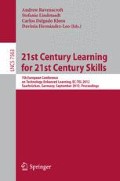Abstract
Orchestration refers to the real-time classroom management of multiple activities and multiple constraints conducted by teachers. Orchestration emphasizes the classroom constraints, integrative scenarios, and the role of teachers in managing these technology-enhanced classrooms. Supporting orchestration is becoming increasingly important due to the many factors and activities involved in the classroom. This paper presents the design and evaluation of TinkerLamp 2.0, a tangible tabletop learning environment that was explicitly designed to support classroom orchestration. Our study suggested that supporting orchestration facilitates teachers’ work and leads to improvements in both the classroom atmosphere and learning outcomes.
Access this chapter
Tax calculation will be finalised at checkout
Purchases are for personal use only
Preview
Unable to display preview. Download preview PDF.
References
AlAgha, I., Hatch, A., Ma, L., Burd, L.: Towards a teacher-centric approach for multi-touch surfaces in classrooms. In: ACM ITS 2010, pp. 187–196 (2010)
Alavi, H., Dillenbourg, P., Kaplan, F.: Distributed Awareness for Class Orchestration. In: Cress, U., Dimitrova, V., Specht, M. (eds.) EC-TEL 2009. LNCS, vol. 5794, pp. 211–225. Springer, Heidelberg (2009)
Alcoholado, C., Nussbaum, M., Tagle, A., Gomez, F., Denardin, F., Susaeta, H., Villalta, M., Toyama, K.: One mouse per child: interpersonal computer for individual arithmetic practice. Journal of Computer Assisted Learning (2011)
Bruner, J.S.: Toward a Theory of Instruction. Belknap Press, Cambridge (1966)
de Jong, T.: The design of effective simulation-based inquiry learning environments. In: Proc of Conf. on Learning by Effective Utilization of Technologies: Facilitating Intercultural Understanding, pp. 3–6 (2006)
DiGiano, C., Patton, C.: Orchestrating handhelds in the classroom with SRI’s ClassSync. In: Proc. of CSCL, pp. 706–707 (2002)
Dillenbourg, P., Jarvela, S., Fischer, F.: The evolution of research on computer-supported collaborative learning. In: Technology-Enhanced Learning, pp. 3–19 (2009)
Dillenbourg, P., Jermann, P.: Technology for Classroom Orchestration. In: Khine, M.S., Saleh, I.M. (eds.) New Science of Learning, pp. 525–552. Springer Science+Business Media, New York (2010)
Dillenbourg, P., Zufferey, G., Alavi, H.S., Jermann, P., Do-Lenh, S., Bonnard, Q., Cuendet, S., Kaplan, F.: Classroom orchestration: The third circle of usability. In: Proc. of CSCL, vol. 1, pp. 510–517 (2011)
Do-Lenh, S., Jermann, P., Cuendet, S., Zufferey, G., Dillenbourg, P.: Task Performance vs. Learning Outcomes: A Study of a Tangible User Interface in the Classroom. In: Wolpers, M., Kirschner, P.A., Scheffel, M., Lindstaedt, S., Dimitrova, V. (eds.) EC-TEL 2010. LNCS, vol. 6383, pp. 78–92. Springer, Heidelberg (2010)
Horn, M.S., Solovey, E.T., Crouser, R.J., Jacob, R.J.: Comparing the use of tangible and graphical programming languages for informal science education. In: CHI 2009, pp. 975–984. ACM, New York (2009)
Hornecker, E., Buur, J.: Getting a grip on tangible interaction: a framework on physical space and social interaction. In: CHI 2006, pp. 437–446 (2006)
Hornecker, E., Marshall, P., Dalton, N.S., Rogers, Y.: Collaboration, interference: awareness with mice or touch input. In: CSCW 2008: Proc. of the ACM Conf. on Computer Supported Cooperative Work, pp. 167–176 (2008)
Jermann, P., Zufferey, G., Dillenbourg, P.: Tinkering or Sketching: Apprentices’ Use of Tangibles and Drawings to Solve Design Problems. In: Dillenbourg, P., Specht, M. (eds.) EC-TEL 2008. LNCS, vol. 5192, pp. 167–178. Springer, Heidelberg (2008)
Kollar, I., Wecker, C., Langer, S., Fischer, F.: Orchestrating web-based collaborative inquiry learning with small group and classroom scripts. In: TEI 2009: Proc. of the 3rd Int. Conf. on Tangible and Embedded Interaction, pp. 77–84 (2011)
Moraveji, N., Kim, T., Ge, J., Pawar, U.S., Mulcahy, K., Inkpen, K.: Mischief: supporting remote teaching in developing regions. In: CHI, pp. 353–362. ACM (2008)
Moraveji, N., Morris, M., Morris, D., Czerwinski, M., Henry Riche, N.: Classsearch: facilitating the development of web search skills through social learning. In: CHI, pp. 1797–1806. ACM, New York (2011)
Mulholland, P., Anastopoulou, S., Collins, T., Feisst, M., Gaved, M., Kerawalla, L., Paxton, M., Scanlon, E., Sharples, M., Wright, M.: nquire: Technological support for personal inquiry learning. IEEE Transactions on Learning Technologies (2011)
Piaget, J.: The future of developmental child psychology. Journal of Youth and Adolescence 3, 87–93 (1974)
Price, S., Falcao, T.P., Sheridan, J.G., Roussos, G.: The effect of representation location on interaction in a tangible learning environment. In: Proc. of TEI, pp. 85–92. ACM, New York (2009)
Price, S., Rogers, Y.: Let’s get physical: the learning benefits of interacting in digitally augmented physical spaces. Comput. Educ. 43(1-2), 137–151 (2004)
Prieto, L.P., Villagrá-Sobrino, S., Jorrín-Abellán, I.M., Martínez-Monés, A., Dimitriadis, Y.: Recurrent routines: Analyzing and supporting orchestration in technology-enhanced primary classrooms. Comput. Educ. 57, 1214–1227 (2011)
Roschelle, J., Rafanan, K., Estrella, G., Nussbaum, M., Claro, S.: From handheld collaborative tool to effective classroom module: Embedding cscl in a broader design framework. Computers & Education 55(3), 1018–1026 (2010)
Schneider, B., Jermann, P., Zufferey, G., Dillenbourg, P.: Benefits of a tangible interface for collaborative learning and interaction. IEEE Transactions on Learning Technologies 4(3), 222–232 (2011)
Stanton, D., Neale, H., Bayon, V.: Interfaces to support children’s co-present collaboration: multiple mice and tangible technologies. In: CSCL 2002: Conf. on Computer Support Collaborative Learning, pp. 342–351 (2002)
Tomlinson, C.: The differentiated classroom: responding to the needs of all learners. Association for Supervision and Curriculum Development (1999)
Zuckerman, O., Arida, S., Resnick, M.: Extending tangible interfaces for education: digital montessori-inspired manipulatives. In: CHI 2005, pp. 859–868 (2005)
Zufferey, G., Jermann, P., Do-Lenh, S., Dillenbourg, P.: Using augmentations as bridges from concrete to abstract representations. In: BCS HCI 2009, pp. 130–139 (2009)
Author information
Authors and Affiliations
Editor information
Editors and Affiliations
Rights and permissions
Copyright information
© 2012 Springer-Verlag Berlin Heidelberg
About this paper
Cite this paper
Do-Lenh, S., Jermann, P., Legge, A., Zufferey, G., Dillenbourg, P. (2012). TinkerLamp 2.0: Designing and Evaluating Orchestration Technologies for the Classroom. In: Ravenscroft, A., Lindstaedt, S., Kloos, C.D., Hernández-Leo, D. (eds) 21st Century Learning for 21st Century Skills. EC-TEL 2012. Lecture Notes in Computer Science, vol 7563. Springer, Berlin, Heidelberg. https://doi.org/10.1007/978-3-642-33263-0_6
Download citation
DOI: https://doi.org/10.1007/978-3-642-33263-0_6
Publisher Name: Springer, Berlin, Heidelberg
Print ISBN: 978-3-642-33262-3
Online ISBN: 978-3-642-33263-0
eBook Packages: Computer ScienceComputer Science (R0)

